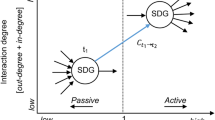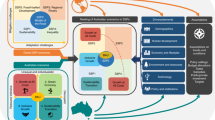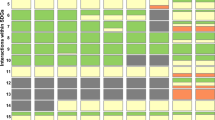Abstract
Understanding the complex interactions among the Sustainable Development Goals (SDGs) is key to achieving all of the SDGs and ‘leaving no one behind’. However, research about dynamic changes of SDG interactions is limited, and how they change as sustainable development progresses remains elusive. Here, we used a correlational network approach and a global SDG database of 166 countries to analyse the evolution of SDG interactions along a progression of sustainable development measured by the SDG Index. SDG interactions showed nonlinear changes as the SDG Index increased: SDGs were both more positively and more negatively connected at low and high sustainable development levels, but they were clustered into more isolated positive connection groups at middle levels. The identification of a process of decoupling followed by re-coupling along the SDG Index strengthens our understanding of sustainable development and may help to suggest action priorities to achieve as many SDGs as possible by 2030.
This is a preview of subscription content, access via your institution
Access options
Access Nature and 54 other Nature Portfolio journals
Get Nature+, our best-value online-access subscription
$29.99 / 30 days
cancel any time
Subscribe to this journal
Receive 12 digital issues and online access to articles
$119.00 per year
only $9.92 per issue
Buy this article
- Purchase on Springer Link
- Instant access to full article PDF
Prices may be subject to local taxes which are calculated during checkout




Similar content being viewed by others
Data availability
All of the data used in this paper can be obtained from the Sustainable Development Report (https://www.sustainabledevelopment.report/) and the World Bank World Development Indicators (https://databank.worldbank.org/reports.aspx?source=world-development-indicators).
Code availability
All computer code used in conducting the analyses summarized in this paper is available from the corresponding author upon reasonable request.
References
Transforming Our World: The 2030 Agenda for Sustainable Development (United Nations, 2015).
Lusseau, D. & Mancini, F. Income-based variation in Sustainable Development Goal interaction networks. Nat. Sustain. 2, 242–247 (2019).
Nilsson, M., Griggs, D. & Visbeck, M. Policy: map the interactions between Sustainable Development Goals. Nature 534, 320–322 (2016).
Pradhan, P., Costa, L., Rybski, D., Lucht, W. & Kropp, J. P. A systematic study of Sustainable Development Goal (SDG) interactions. Earth’s Future 5, 1169–1179 (2017).
Sebestyén, V., Bulla, M., Rédey, Á. & Abonyi, J. Network model-based analysis of the goals, targets and indicators of sustainable development for strategic environmental assessment. J. Environ. Manage. 238, 126–135 (2019).
ISDG Integrated Simulation Tool: Policy Coherence and Integration to Achieve the Sustainable Development Goals (Millennium Institute, 2018); https://www.millennium-institute.org/isdg
Bali Swain, R. & Ranganathan, S. Modeling interlinkages between sustainable development goals using network analysis. World Dev. 138, 105136 (2021).
Griggs, D., Nilsson, M., Stevance, A. & McCollum, D. A Guide to SDG Interactions: From Science to Implementation (International Council for Science, 2017).
Nilsson, M. et al. Mapping interactions between the sustainable development goals: lessons learned and ways forward. Sustain. Sci. 13, 1489–1503 (2018).
Le Blanc, D. Towards integration at last? The sustainable development goals as a network of targets. Sustain. Dev. 23, 176–187 (2015).
Pham‐Truffert, M., Metz, F., Fischer, M., Rueff, H. & Messerli, P. Interactions among Sustainable Development Goals: knowledge for identifying multipliers and virtuous cycles. Sustain. Dev. 28, 1236–1250 (2020).
Zhou, X., Moinuddin, M. & Xu, Z. Sustainable Development Goals Interlinkages and Network Analysis: A Practical Tool for SDG Integration and Policy Coherence (Institute for Global Environmental Strategies, 2017).
Barabási, A.-L., Gulbahce, N. & Loscalzo, J. Network medicine: a network-based approach to human disease. Nat. Rev. Genet. 12, 56–68 (2011).
Saavedra, S., Stouffer, D. B., Uzzi, B. & Bascompte, J. Strong contributors to network persistence are the most vulnerable to extinction. Nature 478, 233–235 (2011).
Bond, R. Complex networks: network healing after loss. Nat. Hum. Behav. 1, 0087 (2017).
Bodin, Ö. et al. Improving network approaches to the study of complex social–ecological interdependencies. Nat. Sustain. 2, 551–559 (2019).
Warchold, A., Pradhan, P. & Kropp, J. P. Variations in sustainable development goal interactions: population, regional, and income disaggregation. Sustain. Dev. 29, 285–299 (2020).
Felipe-Lucia, M. R. et al. Land-use intensity alters networks between biodiversity, ecosystem functions, and services. Proc. Natl Acad. Sci. USA 117, 28140–28149 (2020).
Allen, C., Metternicht, G. & Wiedmann, T. Prioritising SDG targets: assessing baselines, gaps and interlinkages. Sustain. Sci. 14, 421–438 (2019).
Weitz, N., Carlsen, H., Nilsson, M. & Skånberg, K. Towards systemic and contextual priority setting for implementing the 2030 Agenda. Sustain. Sci. 13, 531–548 (2018).
Miola, A., Borchardt, S., Neher, F. & Buscaglia, D. Interlinkages and Policy Coherence for the Sustainable Development Goals Implementation: An Operational Method to Identify Trade-offs and Co-benefits in a Systemic Way (Publications Office of the European Union, 2019).
Zhou, X., Moinuddin, M. & Li, Y. SDG Interlinkages Analysis & Visualisation Tool Version 4.0 (Institute for Global Environmental Strategies, 2021); https://sdginterlinkages.iges.jp
Ospina-Forero, L., Castañeda, G. & Guerrero, O. A. Estimating networks of Sustainable Development Goals. Information & Management https://doi.org/10.1016/j.im.2020.103342 (2020).
Sachs, J. et al. Sustainable Development Report 2020: The Sustainable Development Goals and COVID-19 (Cambridge Univ. Press, 2020).
Dörgő, G., Sebestyén, V. & Abonyi, J. Evaluating the interconnectedness of the Sustainable Development Goals based on the causality analysis of sustainability indicators. Sustainability 10, 3766 (2018).
Kuznets, S. Economic Growth and Income Inequality (Routledge, 2019).
Dinda, S. Environmental Kuznets curve hypothesis: a survey. Ecol. Econ. 49, 431–455 (2004).
Wang, H. et al. China’s CO2 peak before 2030 implied from characteristics and growth of cities. Nat. Sustain. 2, 748–754 (2019).
Grossman, G. M. & Krueger, A. B. Economic growth and the environment. Q. J. Econ. 110, 353–377 (1995).
Paudel, K. P., Zapata, H. & Susanto, D. An empirical test of environmental Kuznets curve for water pollution. Environ. Resour. Econ. 31, 325–348 (2005).
Panayotou, T. Empirical Tests and Policy Analysis of Environmental Degradation at Different Stages of Economic Development (International Labour Organization, 1993).
Eastin, J. & Prakash, A. Economic development and gender equality: is there a gender Kuznets curve? World Pol. 65, 156 (2013).
Wang, G.-z. Reproductive Health and Gender Equality: Method, Measurement, and Implications (Routledge, 2016).
Progress on Sanitation and Drinking Water: 2015 Update and MDG Assessment (World Health Organization, 2015).
WHO Guidelines for Indoor Air Quality: Household Fuel Combustion (World Health Organization, 2014).
Progress on Drinking Water, Sanitation and Hygiene: 2017 Update and SDG Baselines (World Health Organization, 2017).
Mantlana, K. B. & Maoela, M. A. Mapping the interlinkages between Sustainable Development Goal 9 and other Sustainable Development Goals: a preliminary exploration. Bus. Strategy Dev. 3, 344–355 (2020).
Costa, L., Rybski, D. & Kropp, J. P. A human development framework for CO2 reductions. PLoS ONE 6, e29262 (2011).
Omri, A., Nguyen, D. K. & Rault, C. Causal interactions between CO2 emissions, FDI, and economic growth: evidence from dynamic simultaneous-equation models. Econ. Model. 42, 382–389 (2014).
Morrison, T. H. et al. Save reefs to rescue all ecosystems. Nature 573, 333–336 (2019).
Gunningham, N., Grabosky, P. & Sinclair, D. Smart Regulation: Designing Environment Policy (Clarendon Press, 1998).
Axsen, J., Plötz, P. & Wolinetz, M. Crafting strong, integrated policy mixes for deep CO2 mitigation in road transport. Nat. Clim. Change 10, 809–818 (2020).
Wunder, S. et al. From principles to practice in paying for nature’s services. Nat. Sustain. 1, 145–150 (2018).
Salzman, J., Bennett, G., Carroll, N., Goldstein, A. & Jenkins, M. The global status and trends of payments for ecosystem services. Nat. Sustain. 1, 136–144 (2018).
Rogge, K. S., Kern, F. & Howlett, M. Conceptual and empirical advances in analysing policy mixes for energy transitions. Energy Res. Soc. Sci. 33, 1–10 (2017).
Skjærseth, J. B. Towards a European Green Deal: the evolution of EU climate and energy policy mixes. Int. Environ. Agreem. 21, 25–41 (2021).
Fuso Nerini, F. et al. Mapping synergies and trade-offs between energy and the Sustainable Development Goals. Nat. Energy 3, 10–15 (2018).
Csardi, G. & Nepusz, T. The igraph software package for complex network research. InterJournal https://igraph.org (2006).
Wood, S. N. Generalized Additive Models: An Introduction with R (CRC Press, 2017).
Acknowledgements
This research was financially supported by the National Natural Science Foundation of China (42041007, B.F. and S.W.), the National Key Research and Development Program of China (2017YFA0604701, B.F. and S.W.), the China National Postdoctoral Program for Innovative Talents (BX2021042, X.W.), the China Postdoctoral Science Foundation (2021M700458, X.W.) and the US National Science Foundation (1924111, J.L.). We thank M. R. Felipe-Lucia et al. for sharing the R script for network analysis in their publication (www.pnas.org/cgi/doi/10.1073/pnas.2016210117).
Author information
Authors and Affiliations
Contributions
B.F. and X.W. designed the research. X.W., S.W. and S.S. performed the data analysis. X.W., B.F., S.W., S.S., Y.L., Z.X., Y.W. and J.L. contributed to the interpretation and writing.
Corresponding author
Ethics declarations
Competing interests
The authors declare no competing interests.
Peer review
Peer review information
Nature Sustainability thanks Mustafa Moinuddin, Tiffany Morrison and the other, anonymous, reviewer(s) for their contribution to the peer review of this work.
Additional information
Publisher’s note Springer Nature remains neutral with regard to jurisdictional claims in published maps and institutional affiliations.
Supplementary information
Supplementary Information
Supplementary Figs. 1–8 and Tables 1–4.
Rights and permissions
About this article
Cite this article
Wu, X., Fu, B., Wang, S. et al. Decoupling of SDGs followed by re-coupling as sustainable development progresses. Nat Sustain 5, 452–459 (2022). https://doi.org/10.1038/s41893-022-00868-x
Received:
Accepted:
Published:
Issue Date:
DOI: https://doi.org/10.1038/s41893-022-00868-x
This article is cited by
-
Intranational synergies and trade-offs reveal common and differentiated priorities of sustainable development goals in China
Nature Communications (2024)
-
Global effects of progress towards Sustainable Development Goals on subjective well-being
Nature Sustainability (2024)
-
Drawing the line for process design
Nature Chemical Engineering (2024)
-
Historical Changes and Multi-scenario Prediction of Land Use and Terrestrial Ecosystem Carbon Storage in China
Chinese Geographical Science (2024)
-
Reducing risks of antibiotics to crop production requires land system intensification within thresholds
Nature Communications (2023)



